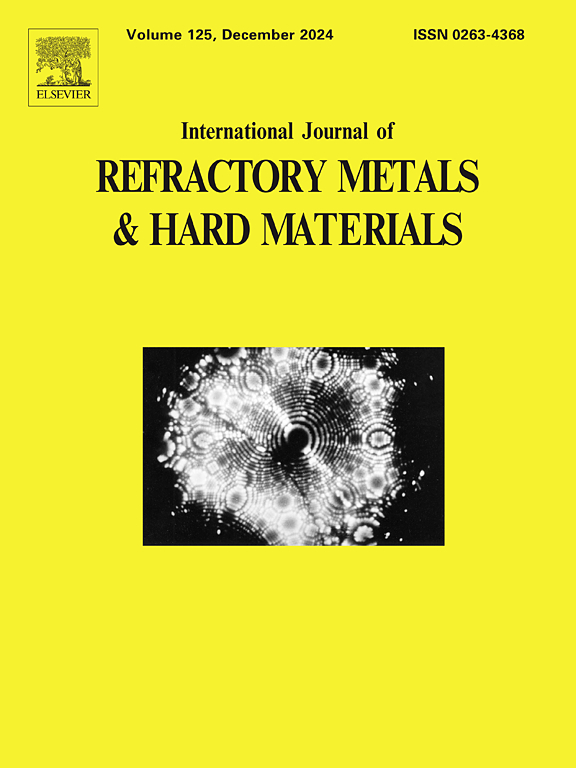Investigation of HVOF-sprayed WC-based coatings on 3D-printed Al-Mg-Sc to improve corrosion and wear performance
IF 4.6
2区 材料科学
Q2 MATERIALS SCIENCE, MULTIDISCIPLINARY
International Journal of Refractory Metals & Hard Materials
Pub Date : 2025-06-28
DOI:10.1016/j.ijrmhm.2025.107296
引用次数: 0
Abstract
A critical issue for the application of SLM-fabricated Al-Mg-Sc alloys in marine environments is their insufficiency of wear and corrosion resistance. In this study, two kinds of WC-based protective coatings, including WC-12Ni and WC-20Cr3C2-7Ni, were deposited onto the surface of a 3D-printed aluminum alloy matrix via HVOF spraying process to simultaneously improve the corrosion and wear resistance. To systematically investigate the correlation between thickness and performance, each coating was fabricated at three distinct thickness levels (100, 200, and 300 μm). The corrosion resistance of both coatings was evaluated through electrochemical analyses, specifically electrochemical impedance spectroscopy (EIS) and potentiodynamic polarization, whereas their wear resistance was quantified using ball-on-disc dry sliding wear tests. After identifying 200 μm as the optimal thickness for both coating series, the post-corrosion and post-wear microstructural evolution of the corresponding specimens was characterized using SEM, XRD, XPS, and 3D profilometry to study the underlying enhancement mechanisms for WC-Cr3C2-2 coating induced by Cr3C2 incorporation. The result reveals that the Cr3C2 addition improves corrosion resistance by simultaneously refining the WC grain structure during deposition and promoting denser passive layer formation. Meanwhile, the fine-grained structure and interphase cohesion in WC-Cr3C2-2 coating can inhibit particle dislodgement, thereby enhancing its wear resistance. In conclusion, this study additionally provides novel research approaches into the surface modification of high-strength Al-Mg-Sc alloys produced through SLM technique.

3d打印Al-Mg-Sc表面hvof喷涂wc基涂层提高腐蚀和磨损性能的研究
slm制备的Al-Mg-Sc合金在海洋环境中应用的一个关键问题是其耐磨性和耐腐蚀性不足。本研究通过HVOF喷涂工艺在3d打印铝合金基体表面沉积WC-12Ni和WC-20Cr3C2-7Ni两种wc基防护涂层,同时提高了其耐蚀性和耐磨性。为了系统地研究厚度与性能之间的相关性,每种涂层都在三个不同的厚度水平(100、200和300 μm)上制备。两种涂层的耐蚀性通过电化学分析,特别是电化学阻抗谱(EIS)和动电位极化来评估,而其耐磨性则通过球盘式干滑动磨损试验来量化。在确定了两种涂层的最佳厚度为200 μm后,利用SEM、XRD、XPS和3D轮廓仪对腐蚀后和磨损后试样的微观组织演变进行了表征,研究了Cr3C2掺杂对wc -Cr3C2涂层的增强机理。结果表明,Cr3C2的加入改善了镀层的耐蚀性,同时细化了WC的晶粒结构,促进了致密钝化层的形成。同时,WC-Cr3C2-2涂层的细晶组织和相间凝聚可以抑制颗粒的位移,从而提高其耐磨性。总之,本研究还为通过SLM技术生产的高强度Al-Mg-Sc合金的表面改性提供了新的研究途径。
本文章由计算机程序翻译,如有差异,请以英文原文为准。
求助全文
约1分钟内获得全文
求助全文
来源期刊
CiteScore
7.00
自引率
13.90%
发文量
236
审稿时长
35 days
期刊介绍:
The International Journal of Refractory Metals and Hard Materials (IJRMHM) publishes original research articles concerned with all aspects of refractory metals and hard materials. Refractory metals are defined as metals with melting points higher than 1800 °C. These are tungsten, molybdenum, chromium, tantalum, niobium, hafnium, and rhenium, as well as many compounds and alloys based thereupon. Hard materials that are included in the scope of this journal are defined as materials with hardness values higher than 1000 kg/mm2, primarily intended for applications as manufacturing tools or wear resistant components in mechanical systems. Thus they encompass carbides, nitrides and borides of metals, and related compounds. A special focus of this journal is put on the family of hardmetals, which is also known as cemented tungsten carbide, and cermets which are based on titanium carbide and carbonitrides with or without a metal binder. Ceramics and superhard materials including diamond and cubic boron nitride may also be accepted provided the subject material is presented as hard materials as defined above.

 求助内容:
求助内容: 应助结果提醒方式:
应助结果提醒方式:


